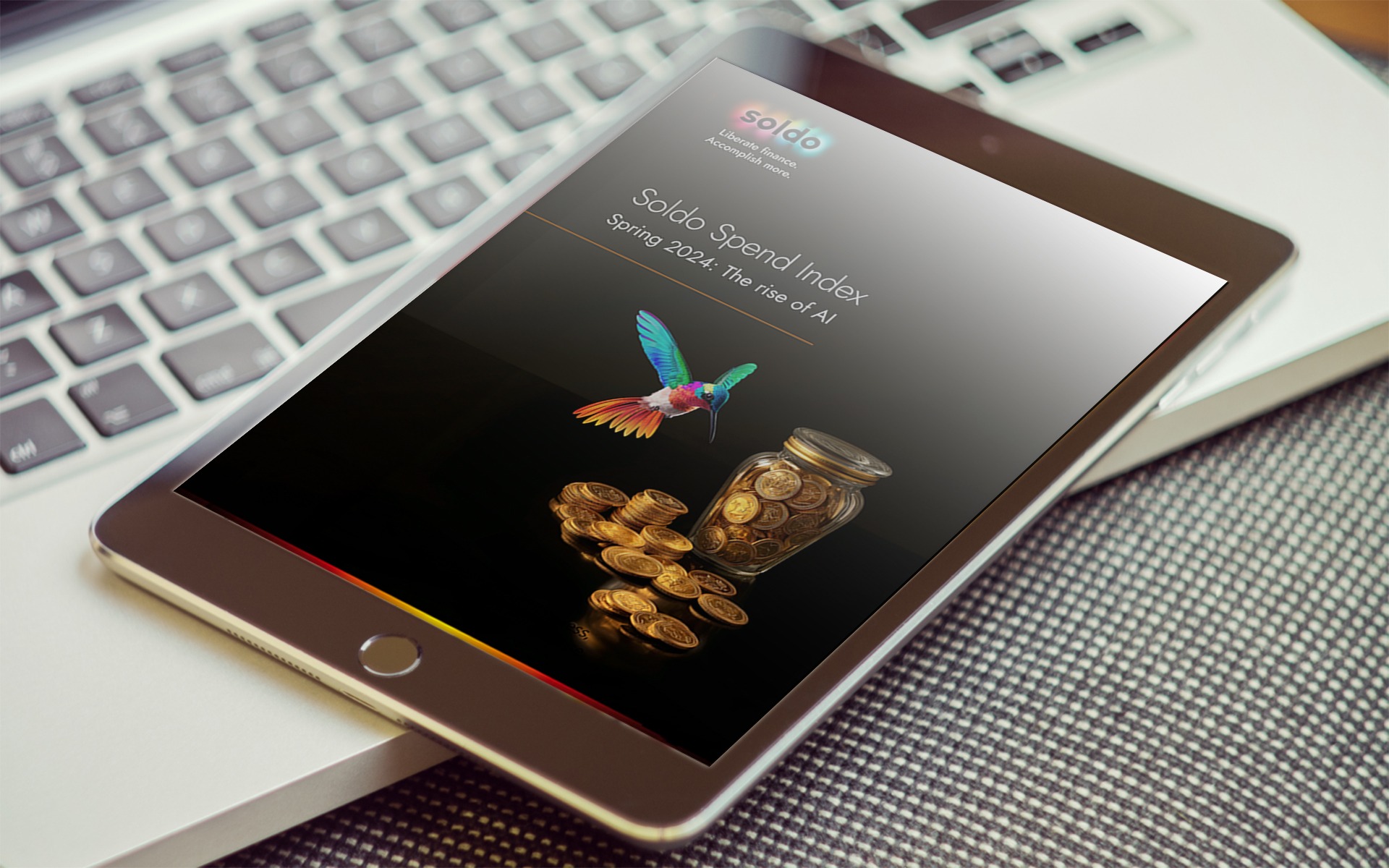Has Finance’s control of company spending changed forever? With Aarish Shah. The Spend Show Ep2
Has Finance’s control of company spending changed forever? With Aarish Shah from Soldo on Vimeo.
We discuss company spending trends since the pandemic in episode 2 of The Spend Show – a show for finance professionals like you. What patterns have we seen and will these continue? How are finance teams responding? Can technology help when budgets are constrained? Aarish Shah (EmergeONE) will be sharing his thoughts with host Hannah Murray-Sykes (Soldo). You’ll be able to ask questions throughout this live session.
What you’ll learn…
💰 Company spending trends: pre-pandemic VS now
💰 The future of company spending
💰 The recovery response from finance teams
💰 The role of technology when it comes to company spending optimisation
👀 Skip to the end for the full transcript or read on to stick with the summary.
Who are the guests?
Aarish Shah is the founder of EmergeONE, a finance-focused growth consultancy that helps ventures to scale. Aarish has been first in finance in a number of businesses from pure start-up all the way through series C scale-ups. He’s geeky about spreadsheets, has a passion for impact ventures and spends an inordinate amount of time figuring out how to extend companies’ runways.
Host, Hannah Murray-Sykes is currently Head of Portfolio Marketing at Soldo. She’s spent her career working in fast-growing FinTech and MarTech businesses, leading multi-disciplinary marketing and commercial product teams. She’s also handy with a foreign language or four.
When’s the next episode of The Spend Show?
Head to our LinkedIn page to see upcoming episodes.
👀 Skip to the end for the full transcript or read on for the show summary.
Do You Know Where Your Budget Is?
This is a question that you’ve probably been asking yourself in the past few months. McKinsey released research entitled “Do you know where your budget is?” in June 2019, where they asked 30 senior executives across a wide range of functions about their views on spending.
Nearly half of respondents said that at least 25% of their expenses – general administrative spend – was invested in the wrong areas relative to the business strategy.
So, this year has definitely been a great time to reevaluate company spending processes. And it’s a reevaluation that happened as soon as the consequences of COVID became clear.
The Initial Impact on Spending
When the pandemic first hit, there was an immediate reaction. Businesses didn’t know what the government was going to do yet, so they had to take matters into their own hands.
Before the crisis, businesses that were scaling were doing a fair amount of recruitment within operations, tech and product teams.
There was also an increase in spending on marketing, sales and automation. Then, when the crisis hit, the first reaction was to reconsider every line item of spend that was ongoing at that moment:
“Triage that. What do we need? What can we do without and what do we need to keep an eye on?”
Recruitment and Office Space
Some of the first casualties to go were recruitment and office space.
There was a widespread hiring freeze while businesses looked at their headcount and decided where to cut, while other firms renegotiated for breathing space on rentals.
Investment Alternatives
Accelerators also started moving their cash flow towards more innovative companies instead of the more risky, people-led, traditional businesses.
For example, the travel industry is drenched with risk, which makes more innovative tech travel companies more appetising to work with.
Marketing
It’s clear that the pandemic has completely changed customer behaviour. So what about customer-facing spend?
One area where spending has reached almost zero is marketing. It’s difficult to determine marketing ROI during an outbreak, which means that you may end up with no return at all.
In terms of marketing, it’s crucial to:
- understand what your business capacity and capability is;
- course-correct on an ongoing basis in terms of how you’re spending your marketing budget.
On the other hand, some businesses saw their top-line increase so much that they had to invent new ways to spend that money. Businesses that were previously struggling saw an incredible amount of capital flow in and had to learn how to scale rapidly.
Overall, whether it’s less spending or more: businesses are more conscious about their spend than they were before the pandemic.
The Switch to Technology
Being conscious about spending means adapting to the situation at hand and making sure your spend is in line with current needs and expectations.
For example, business travel decreased by 92% in April compared to the previous year, which isn’t news at all. But through the first months of the pandemic, the per-business spend on services increased by 81%.
But spending didn’t just stop – it was redirected.
This shows businesses adapted by investing in software to work and collaborate in this new environment, or getting professional services to move their business online.
Another area where technology proved itself useful was homeworking.
Getting the same kind of technology quality at home that you have in the office is difficult. It’s harder to control the peripheral than it is to control the internal.
So businesses have been ramping up spending in home-tech to ensure that the smart working experience is better both for the employee and the business.
This means making sure bandwidth is available, that devices are up to scratch, and adopting collaborative tools like Slack. Overall, anything to make the home working experience as smooth as possible.
That goes for spend management software too. Where you’re managing your spend across multiple divisions, you need effective analytics. Why? Because you no longer have a centralised system of command and control.
Plug-in technologies drive reporting, cash flow management, and your strategic forward cash flow forecasting.
Will We Return to Normality?
We’re preparing for the aftermath.
Furloughs will be stopped or reduced, and unemployment will rocket. The new loans – i.e. the CBIL, bounce back loans, and the Future Fund – translate into future debt. All of this means that revenue is going to continue to be impacted in the near future.
But what should a business do?
Scenario Plan.
If X happens, what do I do?
If Y happens, what do I do?
If this third thing happens, what does that mean and where should I direct my spending?
The future is unpredictable. And forecasting, however loathed right now by finance teams, is just something we have to keep doing. But it’s not all bad for finance teams, considering how they’ve banded together to weather the storm.
After the initial “Oh Lord, what do we do now?”, they started adapting and building communities. The Startup CFO group explores government responses or answer questions as to what people are doing in terms of:
- Spend
- Headcount
- Hiring
- Working from home
- Renegotiating office leases
- What the terms of the Future Fund are
- And much more!
So finance teams, however segregated they have been in the past, have come together and shown solidarity.
This kind of collaboration will definitely play a role in adapting to the future of company spending.
Show Takeaways
Some of the key takeaways from the show
👉 The Soldo Spend Index to see trends in what European businesses are spending money on – from Soldo’s data. Updated monthly.
👉 Companies find that their general administrative spend may be invested in the wrong areas relative to the business strategy.
Hannah: “Over half of respondents said that at least a quarter of their expenses – general administrative spend – was invested in the wrong areas relative to the business strategy.” [00:02:37]
👉 Businesses and finance teams are becoming more conscious about their company spending.
Aarish: “But overall, I think irrespective of whether companies are ramping up their spend or reducing their spend, I think the reality is that they’re much more conscious about their spend than they were necessarily coming into the pandemic.” [00:08:51]
👉 It’s best to have a centralised system where you can see all of your company’s spend, especially in this era of home-working.
Aarish: “Where you’re managing your spend across multiple divisions, you want to have better analytics of how that spend is being spent because you no longer have a centralised system of command and control.” [00:14:49]
Look out for future episodes of The Spend Show on our LinkedIn page.
💬 Full transcript
Hannah 00:00
Welcome to the Spend Show, a new fortnightly webinar exploring trends in Finance and Fintech.
My name is Hannah Murray-Sykes, I’m the Head of Portfolio Marketing at Soldo, a Spend Management Solution complete with prepaid MasterCard cards.
So, in today’s episode, we’ll be talking about company spending in the pandemic, and how are finance teams responding. So today, I’m very pleased to be joined by Aarish – Aarish Shah is the founder of EmergeONE, a finance-focused growth consultancy that works with and in growth ventures to help them scale. Aarish has been first in finance in a number of businesses from pure start-up all the way through Series C scale-ups and he and EmergeONE bring operational and strategic support to the ecosystem through their team of decentralised finance pros.
00:52
He’s geeky about spreadsheets, has a passion for impact ventures, and spends a lot of time figuring out how to extend company runways. Away from his screen, he loves walking and running – maybe not in this weather – and photography, and writes bits and bobs when he can find the time.
So please do ask questions throughout in the chatbox, we’ll have plenty of time to cover those at the end, and today we will be covering the company’s spending topic: company spending trends, so pre-pandemic versus now. We’re talking about the future of company spending, also the recovery response and finance teams and how this is evolving; and then finally, the role of technology when it comes to company spending optimisation and managing those types of processes.
01:42
And so just before we start, just a few facts about company spending.
So at Soldo, we work with tens of thousands of businesses across Europe and what we saw was that what surprised many in April, spending dropped by 41% compared to March. So April, being the first month that a lot of European countries went into full lockdown, it’s not surprising to see that there was a 41% drop across the board in business spending. But lots of companies who survived that first hit have now been taking this opportunity, or being forced to use this opportunity, to re-evaluate their spending habits, McKinsey recently released research entitled “Do You Know Where Your Budget Is?”, which is a question that a lot of finance professionals and business owners have probably been asking themselves in the last few months. And over half of respondents said that at least a quarter of their expenses – general administrative spend – was invested in the wrong areas relative to the business strategy. So, this has been quite a big time for people to reset how it is they look at their company spending processes, where that money is going, how it’s being spent. So, Aarish should be appearing at any moment.
There we go, welcome Aarish.
Aarish 03:07
Thanks Hannah, really appreciate it, great to be here.
Hannah 03:16
So let’s dive right in. How would you say company spending has changed in the last few months versus pre-pandemic, and are there any kind of trends that you’ve seen with all the businesses that you speak to?
Aarish 03:28
Yes, sure. I mean, obviously, it’s hard to generalise about such a vast kind of cadre of businesses and responses as a result of the pandemic. I think you have to look at each and every venture in terms of kind of what their top-line impact was, the sort of funding that they had in place, the government interventions that came through during the course of the pandemic and the responses thereafter to them. I mean, obviously, there were some very clear areas where we saw immediate changes to spending patterns.
So, one which would come as very little surprise to most people is pausing in terms of recruitment. Certainly, pre-pandemic we were seeing a fair amount of recruitment, certainly within operations, within tech and product teams as businesses were scaling. Beyond that, a lot of spend within growth, such as marketing, sales, those sort of areas. And equally, a fair amount of growing spending in automation. So, where the processes could be automated out, those were certainly areas where companies with sufficient kinds of balance sheets were going in and tackling those sorts of problems. As the pandemic hit you had an immediate reaction, which was “right, OK, let’s stop. Let’s reevaluate literally every line item of spend we’ve got at the moment” Triage that, what do we need, what can we do without and what do we need to keep an eye on. Some of the first casualties, I guess, would have been things like office rent.
05:13
So, a lot of renegotiation of office rent, as you’d appreciate. Equally, as I said, spending freezes in terms of hires and equally just looking at headcount in total and deciding whether or not there was a need to rationalise some of that. And obviously that was prior to potentially the furlough scheme coming in place, which may then evolve thinking as well. Other areas where it’s been clear that the spending has dried up in some instances is marketing. So businesses that were fully impacted by the coronavirus pandemic, both in terms of the lockdown and in terms of customer behaviours, will have frozen that kind of marketing spend. And those sectors such as health and leisure, hospitality, travel, etc. But then others may actually be ramping up. We’ve seen businesses that have seen an order of magnitude increase in their top line such that they’re now actually trying to figure out how to spend more money.
Hannah 06:23
So what kind of industries have you found really stand out that they’ve been seeing that increase?
Aarish 06:30
So obviously retail is massive. So, one venture that we’re talking to at the moment has seen a really significant increase in their top line. It wants to be able to capitalise on that and needs to figure out how to scale rapidly and how systems can scale. Other sectors, obviously Healthtech, anything within Edtech, anything with an infrastructure or within Agritech, I think are all areas where there is more spend happening because these were the areas which obviously immediately impacted and had the most to offer, if I can put it that way, in terms of response to covid and the pandemic.
So we’re seeing businesses that possibly struggle to raise for a long period, but as covid hit and the implications came through, capital started flowing into those businesses and their purse strings, therefore, opened up. But it really depends. I mean, if you are facing, let’s say, the education sector, then there is an opportunity, but there is also a risk because of state spend versus private spend. It depends on whether your business is a software business or whether it is a blended business. So those are the sort of industry sectors that are probably seeing that uplift.
08:02
I think the most significant, I would say, is retail or e-commerce. The other area, which has been interesting, I was talking to a pretty well-known accelerator, and they had expectations that their travel tech portfolio was going to see a really significant decline in topline and therefore need to shrink their overhead structure. But what’s happened is because businesses are having to shrink their own costs, they’re looking at alternative methods to make their travel spend more efficient so they’re going to these more innovative companies rather than the kind of more traditional, service-led, people-led travel agencies or travel companies that are out there. So there’s so much nuance and complexity in the question. But overall, I think irrespective of whether companies are ramping up their spend or reducing their spend, I think the reality is that they’re much more conscious about their spend than they were necessarily coming into the pandemic. Although I would again say that for most growth ventures, cash is always critical. So there’s always a fair amount of scrutiny on where they’re spending money.
Hannah 09:17
And I think it’s very difficult to give one answer which encompasses everyone and I don’t know what you found in terms of the marketing spend.
09:32
It always tends to be the first question mark area of how much you should be doing. Obviously, knowing how that top-line growth is moving makes a big difference to make those types of decisions. And have you heard much about how people are looking at those expenses, that variable spending that happens in the background and often you don’t really know how much it is, you might budget for it at the start of the year. Yes, I guess what we’ve seen through our data is that, unsurprisingly, business travel decreased by 92% in April compared to the previous year. Obviously if you can’t physically go anywhere then that’s difficult. But actually, through the couple first months of the pandemic, the per-business spend on services increased by 81% compared the previous year.
00:10:23
So people actually adapting and realising what they needed to spend on software so that they could actually work and collaborate in this new environment, or going to new types of professional services to get that support they needed to potentially move their business online. I don’t know how the businesses you’ve worked with have approached that type of budget, which they have more control over to some extent, versus overheads and recruitment.
Aarish 10:54
Yes, sure, I mean, like variable spend or discretionary spend is obviously a critical part of any business planning. So ,let’s start with the marketing and retail part.
I’ve seen a few different extremes.
11:08
Where we have businesses that effectively have to shut down during the pandemic, obviously their marketing spend has dropped to zero or limited. They may be spending some, they may actually be supplementing previous spending, things like brand or influencer marketing or even referral marketing. But they may not be going off to direct acquisitions or marketing. So, you know, Google ads, Facebook ads, etc, are dropping. And part of the reason for that is that it’s very difficult to understand what your return on that spend is during a pandemic.
So if your business is a consumer facing business that is in a marketplace which is effectively suffering from government legislation, then you could continue to spend marketing dollars, but end up basically with rubbish that is unsupportable in terms of economics. So you’re effectively not able to recover the cost of your marketing spend against the kind of value that that customer is bringing you.
So, I think it’s really critical A) to understand what your business capacity and capability is and then B) really just course-correct on an ongoing basis in terms of how you’re spending those marketing dollars. Other businesses, as I say, are ramping that up because they’re seeing a massive increase in their ability to drive top line because of changes in behaviours both with businesses as well as with consumers. So, you’ve got the whole spectrum and everything in between. But again, it comes back to being really, really on top of what those numbers are telling you and how you should react to them. And then in terms of things like automation, software, travel, obviously – not surprising at all: 100%.
13:13
I think the move to homeworking has led to an interesting dichotomy, which is – within the office, you can control the quality of the Internet, you can control the quality of the devices, you can control the amount of light that one has or, for example, the background behind you on a zoom call. Whereas when you’re working from home, you obviously have limited opportunity or availability for those sorts of things. So absolutely, people are investing and teams are increasing the amount of spend that they’re dedicating towards making that working from home experience not just better for the employee, but for the business overall. So making sure that that bandwidth is available, that their devices are up to scratch in terms of the audio and the visual, but equally collaborative tools like Slack, let’s say, for instance, where you’re spending much more time in the digital community than you are face to face.
So, you need to create those moments of serendipity, as I would call it, where you’re collaborating with someone without even intending to. We’re seeing increased spending in software that manages, for instance… well, Soldo is a great example, right. When you’re managing your spend across multiple divisions, you want to have better analytics of how that spend is being spent because you no longer have a centralised system of command and control.
15:05
Right. It’s much harder to control the peripheral than it is centrally. So you’re seeing increases in that, I think you’re seeing increases in the use of plug-in technologies that drive your reporting, certainly from a finance perspective, that drive reporting, that drive your cash flow management, the drive your strategic forward cash flow kind of forecasting. In terms of management of things like your cap table, things like your various sort of statutory lodgings. And to your point around bringing in and spending more money on professional services, if you’ve been a venture that has been able to get by because your revenue has been relatively stable and you’ve had venture backing and you’ve had enough cash on the balance sheet and all of a sudden a pandemic hits, you’re expecting to go out to fundraise in three or four months… Things have started to look a little harder. You know, your revenues dried up. You’re going to have to start thinking about bringing in people that are able to help guide you through that strategic kind of thinking as to where you go from here.
16:20
A really great example, a venture that I don’t actually work with. I know that their VC backers have told them that the fundraiser they did last year, which effectively was a 12 month runway lasting through till Q3, Q4 this year, now needs to stretch out for another 10 months or so. So, all of a sudden, you’ve got to make that cash last almost double the amount of time that you expected it to, which means that you’ve got to find ways to both decrease cost without compromising top-line or marginal revenue generation. So those are really, really tough decisions and questions to have to answer. And people like the team we have at EmergeONE are exactly the sort of people that understand how to answer those questions. Whereas if you’re a founder that is trying to scramble around to engage with customers, engage with your team, develop the product, influence the tech stack, etc., – these haven’t necessarily been priorities in the past and they’ve started to become priorities now.
Hannah 17:39
Yes, I was wondering how long it would take before cash flow was mentioned. That definitely seems to be the hot topic of the crisis and something that no matter what kind of business you are, you’ve had to put a lot more emphasis on than in the past.
17:58
So, this really is going to affect how companies decide to spend. Do you think moving forwards, this is going to impact potential growth for those fast-growing businesses? Because people just become a lot more cautious and burning through cash, as it has been for the last few years, just won’t be an option anymore.
Aarish 18:22
Yes. So, look, I’m hearing there’s a few things to probably comment on there. Obviously we operate predominantly with venture backed businesses, right? So, most venture-backed businesses right now, if they’re going to the VCs, they’re being told to raise 24 months’ worth of capital. So, have the balance sheet available because we just don’t know what’s going to happen next. If I backtrack six months, at the start of the pandemic we didn’t know what the government was going to do. So, we didn’t know about the CBILS, we didn’t know about the bounce back loan, we didn’t know about the Future Fund, we didn’t know about the furlough scheme. And so therefore, businesses started making decisions, obviously in isolation of those initiatives and policy initiatives that the government was making. As those initiatives started kicking in, things started changing slightly more and companies started, I think, from an initial kind of shock phase, started getting a bit more comfortable understanding where things were at and what was going to happen next. And so, they started dialoguing with their investors around precisely, as you say, cash and cash preservation, new funds and new financings. And we’ve seen let’s say, two examples. We’ve seen Monzo has raised a large round in the last couple of months at a very significant discount to that previous valuation. So it’s quite significant down now. And then you have a company like Revolut, which has released results just this last week, increased their top line – so to your point, growth – tripled their bottom line loss on the back of an increased headcount from somewhere like 600 to over two thousand.
20:10
This is for their last year. And yet they have said that they anticipate turning to profitability this financial year. And a lot of that will have been as a result of focus from investors and certainly a push for that to drive to value. I think we’ve seen that, to be honest, coming through certainly in Europe and to an extent in the US, over the course of the last year. We’ve had situations with WeWork, Uber, and others that have really shone a light on these business models that are high growth, high burn, but actually don’t necessarily make sense from an economics perspective. Uber is still shedding a huge amount of cash. The Uber Eats business, as an example, is definitely not profitable. And yet we’re seeing investments in these areas even today. So, I think that it’s very hard to predict the future but I think that that focus on fundamentals, i.e. unit economics, growth profitability and sustainable growth is definitely much more the rigour than it was even two years ago, a year ago, whatever. I think growth at all costs is no longer acceptable. I think in the UK and Europe, where our venture environment is certainly much, much more risk-averse than the US environment, I think we’re going to see more and more ventures being driven down that path of sustainable growth rather than, as I say, growth at all costs. So 100%, my expectation is that we will see a push to, if not profitability, certainly a reduction in the sort of losses that we’re seeing.
Hannah 22:16
I think profitability seems to be a very under-discussed topic for the last few months so I’m definitely expecting that to become the new cash flow once everyone figures out the fundamentals, as you say.
So, whilst we predict the future, we think about the future of company spending, do you think we really are now just seeing the new normal or, say, in six months’ time, actually we can start going out and living our lives as we were? Will we go back to the way it was or do you think the lessons have been learned?
Aarish 22:55
Wow, that’s a big question. Human beings, I think, by nature are fairly resilient and they’re fairly quick to forget, I think is the honest reality.
What do I think is going to happen in terms of spend? I think we’re going to see, certainly for the immediate future, for the mid-term and I think six months minimum, but probably 12 months, we are going to see a much more cautious approach towards spending. Because I simply don’t see a scenario personally whereby we are going to be confidently out and spending money in the same way that we were pre-pandemic. The UK is a great example where (and I have lots of opinions on this) but we opened up pubs and restaurants earlier during the summer but the government has already talking about, as an example, closing down pubs and restaurants potentially in order to facilitate the reopening of schools. Now, whether they do that or don’t do that, I don’t know but the signal has already been cast. And therefore, if I were in the restaurant business as an example, I would be really, really scratching my head and trying to figure out “What does this mean?” So I think we’re going to see lots of periodic kinds of changes to the way we do things.
24:21
Maybe that’s going to be curbs to transport. That’s going to be quarantines on return from certain areas, as we’ve seen over the course of the last couple of weeks in the UK as well, or from Spain a month or so ago. And therefore, when you have that sort of uncertainty, you have to try and create as much certainty as you can within what you can control and spend is obviously, and for growth ventures, is the one thing that they can control. Revenue is the least certain of their costs that are within their control, and typically are overhead costs and variable costs, which they can shrink up and down with relative ease. So, I don’t think we’re touching the sides of what a new normal may look like. And I actually don’t think that the ‘New Normal’ is a great term because I think actually what we’re seeing is an acceleration of change that is just at a much faster pace than any of us would have anticipated.
I think something came out today, the UK economy effectively shrank by 20-25% and the landlord of Covent Garden has seen the value of their property shrink by nearly £600 000 000, which is a fairly significant number, or something along those lines.
25:49
So, as all of those second order effects start playing out, furlough stopping or being reduced and then stopping in October, all this debt that companies have now taken out between the CBILS and the business bounce back loans, all of that starts kicking in next year. They have to repay that debt. These are not soft loans. And yes, the government has backed them but I don’t think that a bank is not going to pursue that debt. I think the government’s been quite clear that their expectation is not the 80%, as an example, of those loans will fail, but where a few of those loans fail, then they will support 80% of the 80% of the value. I think we’re yet to see the impact of all of those things, you know, the unemployment that’s going to come through, etc.
And what does that mean for companies? It means that revenue probably is going to be impacted and continue to be impacted. So, some of the businesses that I work with have seen a pause in revenue. Some of their traditional customers have basically said, well, OK, we’re going to have to wait a couple of months. We’re still going to spend. We’re just going to see what happens. So, they’ve seen a pipeline increase, but they haven’t seen conversion increase necessarily immediately.
27:15
But they’ve also seen that because the services they offer are really valuable to their customers, that the deal sizes are going up. So, they’re spending later, but they’re spending more. Then I have other companies that I work with who’ve literally had to shut down shop over the course of the pandemic. And I’ve seen a return to some level of pre-pandemic volumes, but they’re like maybe 50, 60, 70% or 80%.
So, what has to happen in those circumstances is that you have to scenario plan. OK, if X happens, what do I do? If Y happens what I do. So if we go back to normal within four months, OK, what does that mean, where should I spend? If we’re at 50% volume, what does that mean, where do I spend? And if I’ve got no revenue, what do I do next? And those are the decisions that I think businesses are being forced into making because we’re in a period where the uncertainty of what happens next is just completely unpredictable. We’ve just seen Russia announce that they have a vaccine and if that is true and it’s proliferated and is accepted globally and can be sort of administered globally, then that’s a game changer in itself.
Hannah 28:36
Yes, and I think that what you say, I think forecasting and reforecasting can probably become the most loathed activities of finance teams, but something that they just have to keep doing.
And how do you think finance teams are responding to these new constraints? And what would you say would be the best approaches to people to be able to keep an eye on everything that’s happening?
Aarish 29:04
That’s a great question. I belong to a group of 600 CFOs. And it’s been really interesting. I joined it as lockdown started. These are all the CFOs predominantly in the UK, but some in Europe, I would say, but none of them are necessarily connected in the sense of working together. But it’s been a great forum to explore some of these government responses or answer questions as to what people are doing in terms of spend, in terms of headcount, in terms of hiring, in terms of working from home, in terms of renegotiating office leases, what are the terms of the Future Fund, etc.
So, I think the really amazing thing is that finance teams, however segregated they have been in the past, have come together and have really shown solidarity and community amongst themselves to really learn. I think, secondly, in terms of internal teams, so just within the business itself, clearly, they’ve become front and centre. So never has it been more critical to know what your cash balance is, what your upcoming spend is, how much runway you have when you need to potentially raise more money, can you afford to take on debt, etc, etc. And I think most finance teams have been really great at responding to that. I think after an initial period of “Oh, my lord, what do we do now?”
31:27
Yes, to an extent, we have one of our team members at EmergeONE, for example, was working with a venture that was going through its series B, their series A lead was leading the round for the series B. COVID hit. Business shut down. The series B was pulled and effectively he had to forecast the business to stretch for the next 6-12 months and make himself redundant. And I think this is the reality of great finance people, is that they will do what’s right for the business. I think that’s the key message for finance teams: where can you really, really assist and move the dial. And that’s both: how can you reduce spend, but equally how can you drive top line and pull levers around margin economics to improve the business profile, and you need to be looking at that constantly. And that’s where I think they’ve proactive instead of reactive.
31:41
I think most finance teams, certainly those that I work with, have been really quick to respond and really proactive as opposed to reactive, which I think is great.
Hannah 31:52
Yes I think, like in all the many articles about your top tips to businesses right now, thinking of the recent one from Forbes, they actually are being quite positive and saying how this big opportunity to set budgets based on financial goals, tidy up both processes and controls that haven’t been done in the past and, as you say, making those really tough pragmatic decisions that in a lot of cases only finance teams are in the position to have all of that information to be able to make those.
So, with regards to actually having access to money and having access to the type of financial information that is needed, how do you think banks and Fintechs have done in regards to adapting, making sure that they can secure their business customers and ensuring not just access to more money, but actually being able to have that data as quickly as possible.
Aarish 32:56
I think, ultimately, big banks and Fintechs are driven by returns, so anecdotally, most of the banks… Wait, I’ll give you a great example. When I heard about the coronavirus business interruption loan scheme about 4 or 5 days before it launched, I talked to the British business banks to understand more about it, then I took it upon myself to call up each of the 40 lenders to understand what their process was going to be, what they were going to look at, how much money they were willing to lend, what the business needed to look like in order to able to be lent to, etc. And effectively, each and every one of those 40 lenders more or less told me the same thing which was: these loans were just not going to be appropriate for early-stage or growth ventures because they just wouldn’t fit some of the requirements. The requirements being that you needed to have been lendable before coronavirus hit for the bank to be able to lend you that.
34:09
And that was a great education as to the reality of banking. I think for a lot of founders and CFOs who maybe have gone through a period, certainly over the last 5 or 6 or 7 years, of huge amounts of dry powder in and out of the venture markets, available more or less on tap, and then all of a sudden needing to go out to traditional finances and finding that OK, hold on, there are pragmatic issues to this, right? Some banks have pulled less traditional lending that they’ve had. So, as an example, one of the major banks pulled its venture debt product, and I don’t know if they’re going to be reissuing that. Some of the Fintechs were able to start becoming issuers of the business bounce-back loan, and I think it was limited to the number of customers that they were able to go to.
35:16
So I think, overall, banks and Fintechs have done what banks and Fintechs do. You know, they are regulated businesses, they have requirements that they have to fulfil. I think they’ve tried to support where they can but I don’t think they’ll support more costs and hazards in reality. The business bounce-back loan, which obviously was very much a government initiative, is probably the only example where… and even that, by the way, some of the processes to avail of that were ludicrous and there were a lot issues.
Hannah 36:02
Yes, I guess like you say, regulating businesses does make it slightly poor in the way that business might have wanted.
So, that brings us on to our last topic for the day. What role do you think technology plays when it comes to optimising the way that companies spend, forecast and run their businesses moving forwards?
Aarish 36:28
Technology has a huge role to play, but the right technology. And one of the issues that I see is that we’ve worked with founders that have been running cloud-based accounting software assuming that that is good enough. And it’s not. And therefore you need to have both the technology as well as the people who can interpret the technology, if I can put it that way.
36:54
I think there are some great tools out there, I think there are some tools that have not yet been built. There are a couple of products that I’ve just seen being developed by companies such as ClearBanc, there’s one called Runway, which I think could be really interesting. In fact, we’re looking at a couple of product builds to really enhance that human aspect with the technology. So, you know, one of the most important things from a finance perspective, I think is understanding where your numbers are, currently, but it’s also forecasting forward and understanding what your numbers will look like.
37:36
The more data-driven that forecasting can become, the better it is for the venture because you’re hopefully starting to plan with much more stability as opposed to previously where you were very much finger in the air and, you know, excel spreadsheets, etc.
37:56
The types of software and automations that a business requires, and here’s the problem, that stack differs from each and every venture. Like what an ecommerce business needs versus what a SaaS business needs, versus what a marketplace business needs will be completely different. And that’s where you need that strong finance team input to make sure that you’re building out that whole ecosystem of software services within the business as comprehensively as possible. And that’s always going to evolve, and I think one of the big problems we see in finance is that the finance stack is never built to scale or, rather, often isn’t built to scale. Therefore, as the business grows, suddenly all of these tools and systems just aren’t adequate because they just haven’t been plugged and thought through in the right way.
38:59
So, I think technology has a huge part to play and obviously as a cost-cutting measure as much as an intuitive addition to the finance stack.
Hannah 39:13
As you say, you don’t want to start bringing in technology that doesn’t last as long as you need it to. So yes, probably not so much the case with the businesses that you work with, but finance teams tend to have a reputation for not liking change, especially when it comes to digital transformation.
Do you think that this has made people realise that they will have to move that forward? One, because they’re not in the same place, but also the need for information to be able to act on that information immediately is so much greater than it was.
Aarish 39:52
Yes, so the way I talk about it is that finance used to be inwards and backwards and what that meant was that they would look inside the business and back into your numbers. Really great finance teams are outwards and forwards, they’re looking outside the business where the opportunities happen – they drive revenue and kind of improve business efficiency – and they’re forwards, they’re looking at what the future is like and what does the future hold and how can they influence that. Like how can they also provide the data and drive decision-making to make the most optimal decisions.
40:29
And I think you’re right, finance teams unfortunately have that reputation. I see that, by the way, in early stages as much as anywhere else because they typically come from a background or environment which is traditional. So we see a lot of people coming out of banking or a practice where automation is too hard and therefore you fix it with people and then you kind of cobble together stuff. I remember when I worked at Deutsche Bank, it was just incredible how many systems plugged in to do two things, just because they acquired legacy systems as they went and they have this whole team of engineers trying to fix that and make that more efficient.
41:21
So, to answer your question, finance has to actually be a part of automation at the heart of automation and digitisation. Why? Because it’s the one part of the organisation that sits across the organisation. Outside of the founding team, finance has its fingers in sales, marketing, operations, in H&R, in legal, it has to know what’s happening and has to be able to influence what’s happening and it can only do that if it is proactive and not reactive, and one of the best ways of doing that is to ensure that you’re bringing in that digital-first mindset into finance.
41:59
We’ve worked in ventures where the finance people that we were replacing had been building the accounts on Excel. That’s just not acceptable, it just isn’t, certainly today. And this is about educating and, I think mentoring, those in the community about what best practices are Certainly, I don’t profess the whole “ultimate knowledge as to what is best practice”, but it’s definitely something that more and more finance teams are looking at.
Hannah 42:39
I guess the thing is that when people talk about bringing in new technology in finance, it’s exactly with your point, finance goes across all functions, and having to understand what’s happening across the board.
How do you think, because the hardest part really is influencing people’s behaviour and making sure that they actually do what they need to do to make that technology work? How do you see people, especially with working from home, trying to speed up that transformation? Are you finding that the two are working well alongside each other or does it tend to still be quite a big change management process that needs to take place?
Aarish 43:21
In more agile businesses it’s easier, and the one thing I advocate for is transparency. So as you’re building out or transforming a process, or even formalising a process, whether that’s through automation or digitisation or whether that’s simply writing down the process for spend, as an example, if you leave that in a cupboard somewhere, no one’s going to see it, no one’s going to follow it. So, therefore you’ve got to be transparent and you’ve got to be collaborative about how you approach those things. And whilst we’re working remotely in a very decentralised fashion, that need to communicate is even more present. I advocate for over-communication rather than under-communication with both of the founders that I work with as well as the teams that I work with. And I think that doesn’t necessarily mean that it makes life easy, it just means that hopefully problems get resolved sooner rather than later, in the sense that you’re not reacting, you’re actually just dealing with them as they arise rather than when something breaks. So, it’s not an easy one because people do resist change as you say, and I think as processes change it’s just hard for some people. But that shouldn’t stand in the way of change. Equally, and I guess this is just one other point I would make, change for change’s sake is not always the best thing either. So I think you’ve got to be really thoughtful about the changes you’re making and why and how they’re driving towards the objectives of the business and of your team as opposed to, let’s say, well look this is a great piece of shiny software, I really like it, I just want to put it in place.











